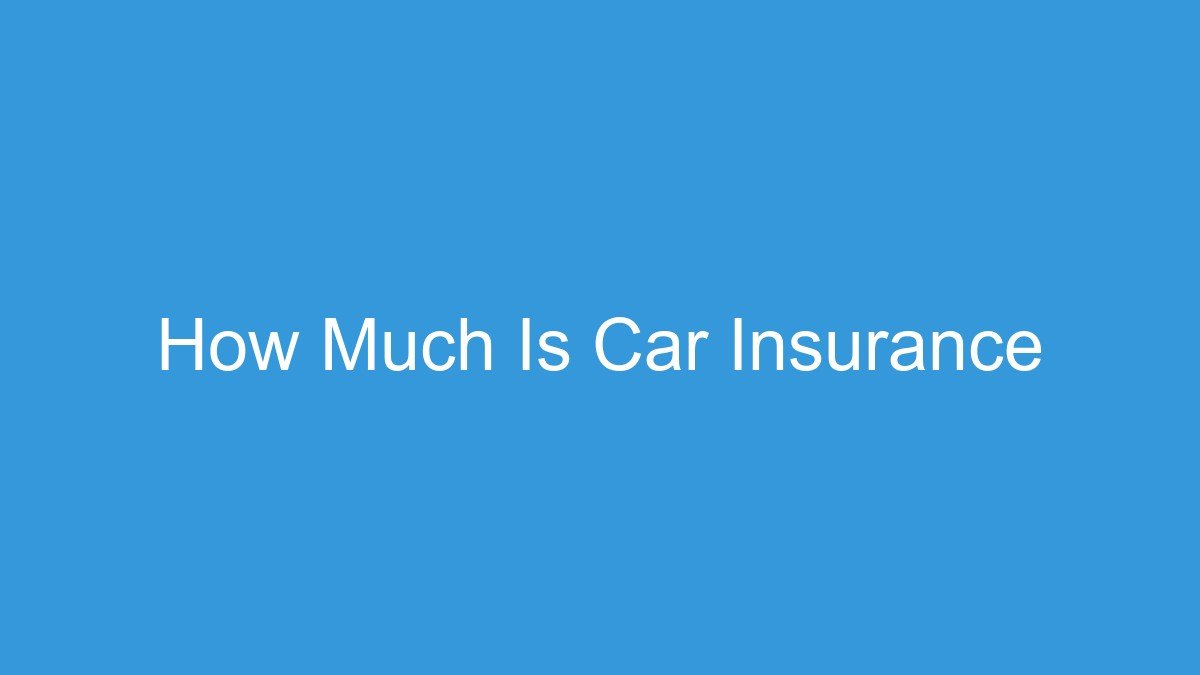
Contents
- How Much Is Car Insurance? Your Ultimate Guide to Understanding Costs & Saving Money
How Much Is Car Insurance? Your Ultimate Guide to Understanding Costs & Saving Money
Ever stared at your car insurance bill and wondered, “How much should this be?” You’re not alone! Car insurance is a necessary expense for nearly every driver, but its cost can feel like a mystery. From protecting you financially after an accident to fulfilling legal requirements, understanding your policy and its price is crucial.
This comprehensive guide will demystify car insurance costs, help you understand the factors that influence your premium, and equip you with practical steps and tips to find the best coverage for your budget. Let’s dive in!
The Big Question: How Much is Car Insurance, Really?
The most common question has the most complex answer: there’s no single, fixed price for car insurance. Your premium is a highly personalized calculation based on a multitude of factors unique to you, your vehicle, and where you live.
🛒 Recommended Product
However, to give you a starting point, the average cost of car insurance in the U.S. can range anywhere from $1,500 to $2,500 per year for full coverage, and significantly less for basic liability-only policies. This is a very broad average, and your actual cost could be higher or lower.
Why such a wide range? Let’s explore the key factors that insurance companies consider when determining your rates.
Key Factors That Influence Your Car Insurance Costs
Insurance companies are essentially assessing risk. The more risk they perceive, the higher your premium will likely be. Here’s what they look at:
Your Personal Profile
- Your Driving Record: This is arguably the most significant factor. A clean driving record with no accidents or traffic violations demonstrates you’re a responsible driver, leading to lower rates. Conversely, a history of tickets, at-fault accidents, or DUIs will drastically increase your premiums.
- Your Age: Younger, less experienced drivers (especially teenagers and those in their early 20s) generally pay the highest premiums due to a higher statistical likelihood of accidents. Rates tend to decrease as drivers gain experience, typically plateauing in their 30s-50s before sometimes rising again slightly for older drivers.
- Your Location (ZIP Code): Where you live matters a lot.
- Urban areas with higher traffic density, theft rates, and vandalism claims often mean higher premiums.
- Rural areas with less traffic usually see lower rates.
- Even within the same city, different ZIP codes can have varying rates based on local crime statistics and accident frequency.
- Your Credit Score (in most states): Many insurance companies use a “credit-based insurance score” as a predictor of how likely you are to file a claim. A good credit score can often lead to lower premiums, while a poor score might result in higher rates. (Note: Some states, like California, Massachusetts, and Hawaii, prohibit the use of credit scores for insurance rating).
- Your Marital Status & Gender: Married individuals are statistically less likely to file claims, so they often pay slightly less than single, divorced, or widowed individuals. Gender can also play a minor role, with young male drivers sometimes paying more than young female drivers, but this difference tends to disappear with age.
- Your Occupation & Education: Some insurers offer discounts for certain professions (e.g., teachers, engineers, first responders) or for higher education levels, as these groups are statistically associated with lower risk.
Your Vehicle
- Make, Model, and Year:
- Expensive, high-performance, or luxury cars cost more to repair or replace, leading to higher premiums.
- Common, moderately priced vehicles are often cheaper to insure.
- Newer cars generally cost more to insure than older ones due to higher replacement part costs and advanced technology, but they also have modern safety features that can sometimes offer discounts.
- Safety Features: Vehicles equipped with modern safety features like anti-lock brakes, airbags, anti-theft devices, blind-spot monitoring, and automatic emergency braking systems can qualify for discounts.
- Vehicle Usage: How much you drive and for what purpose can impact your rates. A car used for daily commuting typically costs more to insure than one used only for pleasure driving on weekends. High annual mileage can also increase rates.
Your Coverage Choices
This is where you have direct control over a significant portion of your premium.
- Types of Coverage:
- Liability Coverage: Mandatory in most states, this covers damages and injuries you cause to other people and their property. It’s the most basic and typically cheapest coverage.
- Collision Coverage: Pays for damage to your car if you hit another vehicle or object, regardless of fault.
- Comprehensive Coverage: Covers damage to your car from non-collision events like theft, vandalism, fire, natural disasters, or hitting an animal.
- Other Coverages: Personal Injury Protection (PIP), Medical Payments (MedPay), Uninsured/Underinsured Motorist (UM/UIM) coverage, roadside assistance, and rental car reimbursement all add to your premium but offer valuable protection. The more types of coverage you add, the higher your premium will be.
- Deductible Amount: This is the amount you pay out-of-pocket before your insurance kicks in for collision and comprehensive claims. A higher deductible typically means a lower premium, as you’re taking on more of the initial risk. A lower deductible means a higher premium.
- Coverage Limits: These are the maximum amounts your insurance company will pay out for a covered claim. Higher limits provide more protection but result in higher premiums. Conversely, choosing the minimum required liability limits will lead to lower premiums but leaves you vulnerable to significant out-of-pocket expenses if an accident exceeds those limits.
Step-by-Step: How to Get Your Personalized Car Insurance Quote
Ready to find out your specific cost? Follow these steps to get accurate quotes and compare your options:
-
Gather Your Information: Before you start, have all necessary details handy. This will make the process much smoother.
- Personal Information: Your full name, date of birth, driver’s license number, marital status, occupation, education level, and current address.
- Vehicle Information: Make, model, year, VIN (Vehicle Identification Number), current mileage, and primary usage (commute, pleasure, business).
- Driving History: Any past accidents (date, fault, claim amount), traffic violations (date, type), and previous insurance history (provider, policy number, dates of coverage).
- Other Drivers: Information for anyone else who will be driving your car regularly (name, DOB, license #).
-
Understand Your Coverage Needs: Don’t just pick the cheapest option without understanding what it covers.
🛒 Recommended Product
- State Minimums: Know your state’s minimum liability requirements. This is the absolute least you can get.
- Evaluate Your Car’s Value: If your car is older and paid off, comprehensive and collision coverage might not be cost-effective. If you have a loan or lease, these coverages are usually required.
- Assess Your Financial Risk Tolerance: How much could you comfortably pay out-of-pocket if you caused a serious accident? Higher liability limits offer better protection for your assets.
-
Shop Around – Compare Quotes from Multiple Providers: This is the most critical step for finding the best price. Insurance rates vary significantly between companies, even for the exact same coverage.
- Online Quote Tools: Most major insurance companies offer instant online quotes.
- Independent Agents: These agents work with multiple insurance companies and can shop around for you, providing several options.
- Direct Insurers: Companies that sell policies directly to consumers (often online or by phone) may offer competitive rates.
- Get at least 3-5 quotes to get a good sense of the market.
-
Compare Quotes Accurately: Don’t just look at the bottom line.
- Ensure “Apples to Apples”: Make sure all quotes are for the same types of coverage, deductibles, and limits. A lower price might mean less coverage.
- Review Discounts: Check what discounts each company applied or could apply.
- Understand Terms: Make sure you understand the policy terms, cancellation policies, and claim processes.
-
Ask Questions: If anything is unclear, call the insurance company or agent.
- “What exactly does this coverage protect me from?”
- “Are there any other discounts I might qualify for?”
- “What is your claims process like?”
-
Choose and Purchase Your Policy: Once you’ve selected the best option, you can typically purchase the policy online, over the phone, or in person. Be prepared to provide payment information and confirm your details.
Tips for Lowering Your Car Insurance Costs
Even with factors you can’t change, there are many ways to actively reduce your premium:
- Maintain a Clean Driving Record: This is paramount. Avoid accidents and traffic violations at all costs. Safe driver discounts are significant.
- Increase Your Deductible: If you have an emergency fund, raising your collision and comprehensive deductibles from $500 to $1,000 (or more) can noticeably lower your premiums. Just ensure you can afford the higher out-of-pocket expense if you need to file a claim.
- Bundle Your Policies: Many insurers offer discounts when you bundle car insurance with other policies like home, renters, or life insurance.
- Ask About Discounts: Always ask your agent or review the company’s website for available discounts. Common ones include:
- Multi-car discount
- Good student discount
- Defensive driving course discount
- Low mileage discount
- Anti-theft device discount
- Loyalty discount
- Automatic payment discount
- Paid-in-full discount
- Improve Your Credit Score: If permitted in your state, a better credit score can lead to lower rates.
- Choose the Right Car: Before buying a new vehicle, research its insurance costs. Some models are inherently cheaper to insure than others.
- Consider Telematics Programs (Usage-Based Insurance): Many insurers offer programs where a device or app monitors your driving habits (speed, braking, mileage). Safe drivers can earn significant discounts through these programs.
- Review Your Policy Annually: Your life changes, and so should your insurance. Annually review your coverage needs and shop around again to ensure you’re still getting the best rate.
- Pay Annually (if possible): Many companies offer a discount for paying your entire premium upfront rather than monthly installments.
- Drop Unnecessary Coverage: For older cars whose market value is less than the cost of comprehensive and collision deductibles plus a few years of premiums, consider dropping these coverages.
Common Mistakes to Avoid When Shopping for Car Insurance
Don’t let these pitfalls cost you more money or leave you underinsured:
- Only Getting One Quote: This is the biggest mistake. You could be leaving hundreds or even thousands of dollars on the table by not comparing rates from multiple companies.
- Underinsuring Yourself: Choosing only the minimum liability coverage required by your state might seem cheap upfront, but it can lead to devastating financial consequences if you cause a serious accident and damages exceed your limits. Always buy as much liability coverage as you can reasonably afford.
- Overinsuring an Old Car: Paying for full comprehensive and collision coverage on a car worth only a few thousand dollars might not be a wise investment, especially if your deductible is a significant portion of its value.
- Forgetting to Update Your Information: Changes in your life (marriage, moving, a new job, children leaving home) can affect your rates. Keep your insurer updated to ensure accurate pricing and potential new discounts.
- Ignoring Available Discounts: Always ask about every possible discount. Insurance companies won’t always automatically apply them.
- Focusing Only on Price: While cost is important, don’t sacrifice adequate coverage or good customer service for the absolute lowest premium. A slightly cheaper policy that denies your claim or provides poor service isn’t a good deal in the long run. Read reviews and consider the company’s reputation.
- Lying on Your Application: Providing false information to get a lower rate is considered fraud. If discovered, your policy could be canceled, and future claims denied, leaving you unprotected and facing legal issues.
Conclusion
Understanding “How Much Is Car Insurance?” is a journey of understanding risk, personal circumstances, and smart shopping. While there’s no magic number, by grasping the factors that influence your premium, proactively seeking multiple quotes, and applying savvy money-saving tips, you can feel confident that you’re getting the right coverage at a fair price.
🛒 Recommended Product
Don’t let the complexity intimidate you. Take control of your car insurance costs today by gathering your information and starting the quote comparison process. Your wallet (and your peace of mind) will thank you!
FAQ
Q. What factors determine the cost of my car insurance?
A. Your car insurance premium is influenced by a multitude of factors, including your driving record (accidents, violations), age, gender, geographic location, type of vehicle (make, model, safety features, repair costs), annual mileage, credit score (in most states), marital status, chosen coverage limits and deductibles, and even where you park your car. Each insurer also has its own underwriting algorithms, leading to variations in quotes.
Q. What is the average cost of car insurance in the U.S.?
A. The average cost of car insurance in the U.S. varies significantly by state and individual circumstances, but it typically ranges from $1,500 to $2,500 per year for full coverage. This is a broad average, and your specific premium could be considerably higher or lower based on the factors mentioned above. Liability-only policies are generally cheaper.
Q. How can I reduce my car insurance premiums?
A. There are several effective ways to lower your premiums: maintain a clean driving record, shop around and compare quotes from multiple insurers, inquire about discounts (e.g., multi-policy, good student, safe driver, low mileage, anti-theft devices), increase your deductibles, reduce unnecessary coverages on older vehicles, improve your credit score, and consider usage-based insurance programs.
Q. Why did my car insurance rate increase?
A. Your rates can increase for various reasons. Common causes include filing a claim, receiving a traffic ticket, a change in your credit score, moving to a higher-risk area, adding a new driver to your policy, or simply general rate hikes by your insurer due to increased claims across their customer base or economic factors like inflation and repair costs. Even if you haven’t had any incidents, industry-wide trends can affect your premium.
Q. Does my credit score affect my car insurance rates?
A. Yes, in most states, your credit-based insurance score (which is related to, but distinct from, your traditional credit score) is a significant factor used by insurers to determine your premium. Studies have shown a correlation between a higher credit-based insurance score and a lower likelihood of filing claims, leading to lower rates for those with better scores. However, some states, like California, Hawaii, Massachusetts, and Michigan, prohibit the use of credit scores in setting car insurance rates.
Q. Is it cheaper to pay my car insurance monthly or annually?
A. Generally, it is cheaper to pay your car insurance premium annually or semi-annually in one lump sum. Insurers often offer a discount for paying in full because it reduces their administrative costs and the risk of you missing payments. Paying monthly usually incurs installment fees or higher overall costs, making the total premium more expensive over the year.
Q. How does the type of car I drive impact my insurance cost?
A. The type of car significantly affects your premium. Factors considered include its safety ratings (safer cars may get discounts), theft rates (frequently stolen models cost more), repair costs (expensive parts or complex repairs increase comprehensive and collision costs), engine size/horsepower (sportier cars often cost more to insure), and the car’s market value (more expensive cars generally have higher comprehensive and collision premiums).
Related Articles
How Much Does a Tesla Cybertruck Cost
How Much Does a Tesla Cybertruck Cost? Your Ultimate Guide to Pricing & Purchase The Tesla Cybertruck has captured imaginations with its futuristi…
How Much Is a Tesla
How Much Is a Tesla? Unpacking the Cost of Your Dream EV Dreaming of driving a Tesla? You’re not alone! These innovative electric vehicles have …
Affiliate Disclosure: As an Amazon Associate, I earn from qualifying purchases made through links on this site.















